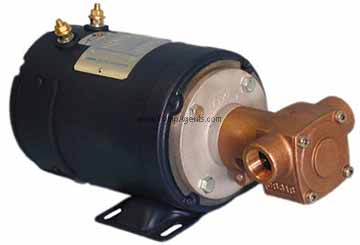Oberdorfer # 406M-4N75 Bronze Sewage Transfer Macerator Pump and Motor 1 Horsepower

Oberdorfer # 406M-4N75
Oberdorfer catalog # 406M-4N75, Bronze Sewage Transfer Macerator Pump and Motor unit, Bronze construction, Neoprene impeller, Stainless Steel Shaft. Motor is 1 Horsepower, 1800 RPM, 12 Volts DC, TEFC (Totally Enclosed Fan Cooled). Inlet Port is 1-1/2 inch Male NPT and 2 inch Hose Inlet, 1 inch Female NPT and 1-1/2 inch Hose Outlet, Discharge Port is 1-1/2 inch Male NPT and 2 inch Hose Inlet, 1 inch Female NPT and 1-1/2 inch Hose Outlet.
Price : $ 2797.20
Product Information :
The Oberdorfer 406M-4N75 is a Bronze Sewage Transfer Macerator Pump and Motor unit with a Neoprene Impeller, 1-1/2 inch Male NPT and 2 inch Hose Inlet, 1 inch Female NPT and 1-1/2 inch Hose Outlet Ports, close coupled to a 1 Horsepower, 1800 RPM, 12 Volts DC, TEFC (Totally Enclosed Fan Cooled) Motor. This bronze sewage transfer/macerator pump is corrosion resistant, is constructed from marine quality bronze and stainless steel for ruggedness and reliability, and features a stainless steel shaft. This Pump has one moving part - a tough, long-lived, wear-resistant flexible impeller lubricated by the liquid being pumped. No metal-to-metal pumping action - no gears to jam, clog or become noisy. Flexible blades on the periphery of the impeller provide the pumping action. While the impeller rotates, the liquid between the blades is continuously squeezed out into the discharge port by a cam located inside the pumping chamber. The flow may be throttled or shut off for a short period without the need of a relief valve. These pumps are designed to be fully serviceable and after long use can be restored to like new condition, avoiding complete pump replacement. The impeller and cam are easily replaced. The Flexible Impeller in this pump generates high rubbing friction unless lubricated by the liquid being pumped. A lack of liquid will cause the impeller to degrade rapidly. On initial start-up pump must be primed to prevent dry-running of the impeller. This pump is self-priming, and will self-prime at low or high speeds. It will pump instantly, and a suction lift of 15 feet is possible when impeller is wet and pump fully primed. Suction lines must be air tight in order for pump to self prime. A foot valve at the beginning of suction line is recommended. This Macerator Pump can be configured to run in either rotation, however, once the configuration is set, it becomes a uni-directional pump. Due to the macerator feature, the pump will not function in both rotating directions during operation. The Temperature limits for the Neoprene impeller in this pump is 45 degrees F to 180 degrees F ( 7 degrees C to 82 degrees C). Pumping colder water than 45 degrees F will shorten the impeller life.
WEIGHT : The Oberdorfer 406M-4N75 weighs 49 Lbs.
Features :
Applications
Typical Applications for the 406M4N75 pump are Sewage Transfer, Dockside Pumpout, Holding Tank Pumpout for Campers, Campsites, Trailers, Mobile Homes, General Utility, and Emergency applications, and pumping liquids that are compatible with the neoprene impeller such as fresh and salt water solutions and mild chemicals. Marine uses include Bilge, Washdown, Baitwell and General Transfer. Do not pump gasoline, severe solvents or acids. When possible flush pump with fresh water after each usage. Limits of 40 degrees F to 140 degrees F should be maintained. Do not allow liquid in pump to freeze, and when not in use for long periods of time you can drain pump by removing drain plug provided, located at bottom of pump body. Use methyl alcohol based antifreeze compounds such as Zerex, Shell Sone, Pyro Permanent, Permagard, Dowgard. This flexible impeller pump can operate in either rotational direction. It combines the priming feature of positive displacement type pumps with the general transfer ability of centrifugal pumps. It will pump either thin or viscous liquids and can handle more solids in suspension than other types of rotary pumps. It operates at low or high speeds can be mounted at any angle and pumps in either direction with equal efficiency. Direction of shaft rotation determines inlet and outlet ports. Prior to installation, rotate the pump manually in direction of rotation to set flexible blades in direction desired.
The impeller must be replaced if it is worn out or has been damaged by debris or by running the pump dry. Symptoms of a defective impeller are low pumping pressure and low flow. To replace the impeller remove screws and cover. Pull out the impeller with nose pliers or two screwdrivers. Be careful not to dent the pumping chamber with these tools. When inserting new impeller, line up key slot in impeller with the key in the shaft. Use oil on shaft and avoid forcing the impeller onto the shaft. The impeller should also be removed for storage periods to prevent the blades from taking a permanent set.